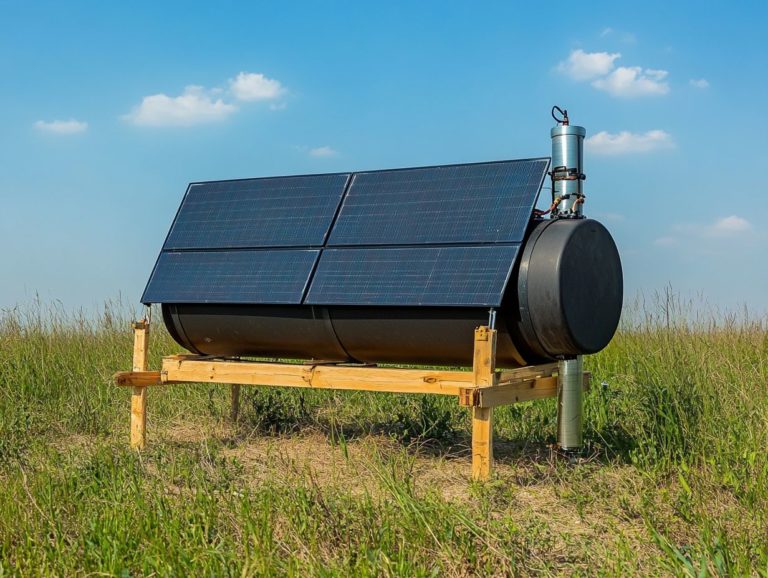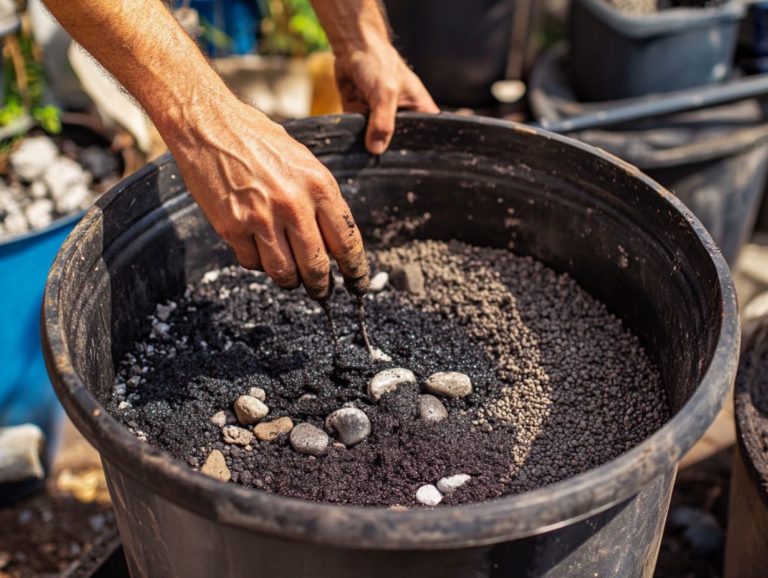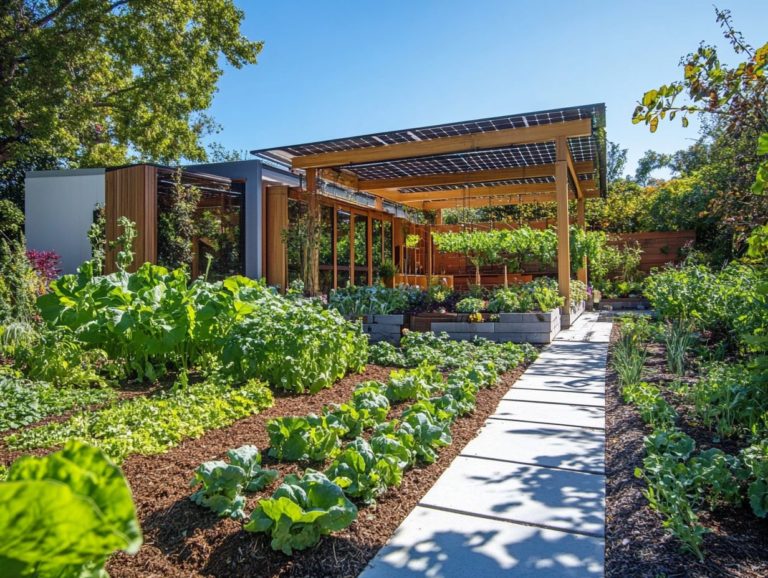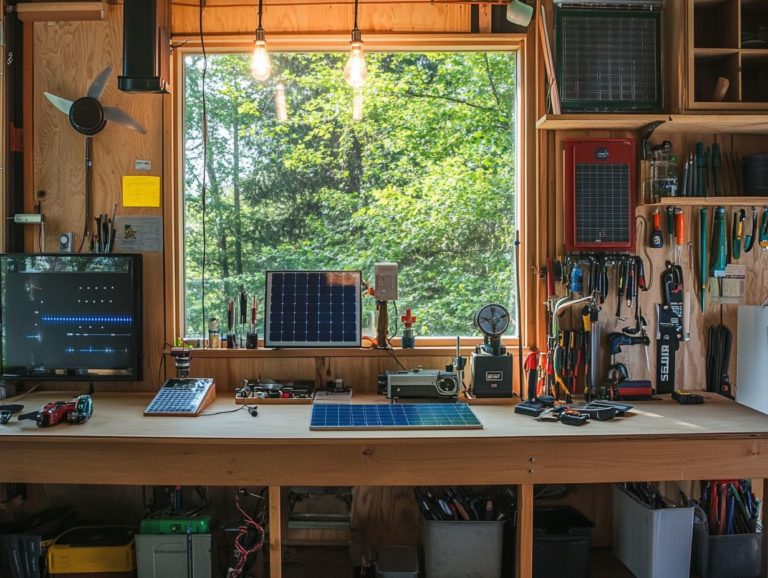10 Simple DIY Projects to Save Energy
Are you eager to reduce your energy bills while making your home more eco-friendly and energy efficient? You re in the right place to start saving money and energy today!
This article delves into ten straightforward DIY projects designed to help you conserve energy and save money. Whether it s changing out light bulbs, sealing air leaks with caulk, or upgrading to energy-efficient appliances, these easy-to-implement solutions will elevate your home s efficiency and contribute to a healthier planet.
Explore practical energy-saving tips that anyone can take on, along with the long-term benefits and incentives that make these projects all the more enticing.
Contents
- Key Takeaways:
- 1. Install LED Light Bulbs
- 2. Use Power Strips
- 3. Seal Air Leaks
- 4. Insulate Your Attic
- 5. Install a Programmable Thermostat
- 6. Use Natural Light
- 7. Upgrade to Appliances That Save Energy
- 8. Install Low-Flow Showerheads and Faucets
- 9. Plant Shade Trees
- 10. Use Power-Saving Settings on Electronics
- How Can These DIY Projects Save Energy and Money?
- Frequently Asked Questions
- 1. What are some easy DIY projects to help save energy in my home?
- 2. How much energy can I save by doing these 10 DIY projects?
- 3. Do I need any special tools or skills to complete these projects?
- 4. Can these DIY projects also help the environment?
- 5. Are these projects cost-effective?
- 6. Will these DIY projects make a noticeable difference in my energy usage and home comfort?
Key Takeaways:

- Switch to LED light bulbs to cut energy use and save money!
- Use power strips and turn off electronics when not in use to eliminate energy waste caused by devices that consume power even when turned off.
- Seal air leaks with caulk, apply weatherstripping to doors, and utilize natural light to greatly increase energy efficiency in your home.
1. Install LED Light Bulbs
Installing LED light bulbs in your home stands out as one of the simplest yet most impactful DIY projects to elevate your energy efficiency, cut down on energy consumption, and significantly shrink your energy bills all while embracing sustainable living practices.
By choosing these innovative lighting solutions, you’ll witness a remarkable reduction in your electricity costs and enjoy the benefits of their impressive lifespan, which can outlast traditional incandescent bulbs by up to 25 times. This durability means fewer replacements and less waste, making LED bulbs a smart, environmentally conscious choice. They consume substantially less energy often up to 80% less resulting in lower carbon emissions and reduced strain on power plants.
Many of these energy-efficient lighting options proudly carry the ENERGY STAR rating, a mark of their exceptional performance and efficiency. They effortlessly fit into broader energy conservation initiatives aimed at reducing your carbon footprint while contributing to global sustainability efforts.
2. Use Power Strips
Utilizing power strips is a savvy approach for tackling energy vampires lurking in your home. These are devices that consume power even when turned off, enabling you to save energy and effortlessly reduce your overall household energy consumption.
These handy devices allow multiple electronics to connect to a single outlet while providing a simple way to cut power completely when not in use. This is essential for minimizing standby power loss. By turning off these devices, you can significantly lower your energy costs.
In today s tech-savvy world, smart power strips present an innovative solution, intelligently managing power to your devices. They detect when devices are not in use and automatically shut them off, perfectly balancing energy savings with convenience.
3. Seal Air Leaks
Sealing air leaks in your home is essential for enhancing energy efficiency, as it directly impacts your heating costs and overall comfort by preventing conditioned air from escaping. Consider using products like draft excluders and insulation tape to seal even the smallest gaps.
Common areas for air leaks include windows, doors, and poorly insulated attics. By applying caulk around window frames and door edges, you can create an airtight barrier that significantly reduces drafts. Adding weatherstripping to doors and using window insulation kits during colder months can provide an effective seal against outside air, further elevating your home’s energy efficiency.
Using insulation blankets for your water heaters and ducts helps maintain temperature and lower your energy bills. Using radiator reflector panels can redirect heat back into your living space. By addressing these leaks and boosting insulation, you can vastly improve your overall comfort, resulting in a cozier living environment during those chilly months.
Start these DIY projects now to see immediate savings on your energy bills!
4. Insulate Your Attic
Insulating your attic is a highly effective energy-saving strategy to minimize heat loss during winter, ultimately reducing your energy consumption. This not only leads to lower heating bills but also enhances the efficiency of your heating system, making it an excellent home improvement investment.
You have a variety of insulation materials at your disposal to achieve optimal results, with fiberglass and foam topping the list as popular choices. Fiberglass insulation is renowned for its excellent thermal resistance (how well a material can resist heat flow) and is often found in batts or loose-fill forms, making it simple to install in various attic configurations. Foam insulation excels in air sealing and effectively combats moisture accumulation, which is essential for maintaining a healthy attic environment.
Both materials can be used in combination with insulation tape for maximum effectiveness. Proper installation of these materials is crucial; any gaps or compressed areas can significantly reduce their effectiveness. By investing in high-quality insulation and considering attic insulation upgrades, you not only create a more comfortable living space throughout the year but also unlock long-term energy savings that can significantly impact your overall utility cost.
5. Install a Programmable Thermostat
Installing a programmable thermostat is a savvy investment that empowers you to optimize your heating and cooling schedules, resulting in significant energy savings and reduced heating costs throughout the year. For even greater savings, consider upgrading to a smart thermostat.
These devices help you control the temperature accurately throughout the day and adapt seamlessly to your lifestyle, ensuring that energy isn t wasted when your home is unoccupied. Smart thermostats elevate this experience by incorporating learning capabilities and remote access, enabling you to manage your home s climate from virtually anywhere while receiving alerts about your energy usage patterns. This is a key component of modern energy-efficient projects.
With many utility providers offering enticing rebates for upgrading to energy-efficient models, you can enjoy immediate financial benefits along with long-term savings on your energy bills. This investment can dramatically cut your energy costs and enhance your comfort! By embracing such technologies, you re boosting your comfort while playing a part in creating a sustainable future!
6. Use Natural Light

Maximizing natural light in your home not only elevates your living space but also promotes energy savings, reducing your reliance on artificial lighting and embracing a more energy-efficient lifestyle. This approach is often recommended by energy experts for its simplicity and effectiveness.
To achieve this, consider the important role of thoughtful window placement, allowing sunlight to filter into key areas throughout the day. Opting for lighter paint colors on your walls can amplify brightness, infusing a sense of openness and airiness into your rooms. Strategically incorporating mirrors will reflect sunlight, enriching the ambiance while adding a touch of depth to your space.
Using faux stone panels in key locations can enhance the look of your space while allowing light to flow. However, it’s crucial to strike a balance; too much light can lead to discomfort or unwanted heat build-up. By creating cozy zones with softer furnishings, you can maintain a warm atmosphere while still enjoying the delightful benefits of natural illumination.
7. Upgrade to Appliances That Save Energy
Upgrading to appliances that save energy is a smart strategy for reducing your energy bills. These appliances use less energy while providing the same performance, leading to significant savings.
This is an essential step in any home energy conservation plan. Often bearing the ENERGY STAR label, these models meet strict efficiency standards set by the U.S. Environmental Protection Agency and the Department of Energy.
By investing in energy-saving options like water heaters and refrigerators, you lower your utility costs and reduce your environmental footprint. This creates a meaningful difference for the planet. Some models even have compact designs and stone-like finishes to blend seamlessly with modern decor.
Many local and state governments offer energy rebates for homeowners who choose these upgrades. This makes the decision even more appealing for those looking to boost their home s efficiency.
By embracing these upgrades, you re not just saving money; you re joining a movement to protect our planet!
8. Install Low-Flow Showerheads and Faucets
Installing low-flow showerheads and faucets is an excellent way to conserve water and save energy. This can lead to lower energy costs tied to heating water and foster a more sustainable household.
These fixtures cut down on how much water comes out without sacrificing performance. They typically deliver a flow rate of 1.5 to 2.5 gallons per minute, compared to traditional options that can use up to 5 gallons or more.
Pairing these fixtures with water-saving devices can amplify the benefits. These simple devices mix air with the water flow, creating a fuller, satisfying stream while using significantly less water.
Start saving money and water today by installing low-flow showerheads and faucets! Together, these innovations greatly reduce overall water use, resulting in notable savings on your utility bills and a positive impact on the environment.
9. Plant Shade Trees
Planting shade trees around your home is not just a charming addition; it s an eco-friendly strategy that can significantly boost your energy savings. This method can cut down on heating costs by blocking that relentless summer sun.
These trees serve as natural air conditioners, lowering surrounding temperatures and creating a more pleasant backyard. This advantage is especially valuable in urban areas, where heat islands can amplify discomfort.
When selecting trees, consider their mature size, growth rate, and leaf density. Deciduous trees provide shade in summer while allowing sunlight to warm your home in winter.
Strategic placement is key. Aim to shade west and south-facing windows to optimize cooling and energy efficiency. This transforms your outdoor area into a sustainable oasis.
10. Use Power-Saving Settings on Electronics
Implementing power-saving settings on your electronics is a straightforward yet impactful strategy to reduce energy consumption and save power without compromising performance in your daily activities.
By spending just a few moments exploring these settings, you can significantly lower your electricity bills while contributing to a greener planet. Whether you’re adjusting the brightness and sleep settings on your computer, enabling energy-saving modes on your television, or setting timers on your gaming console, every small change matters. For more tips, check out this guide on how to make your home more energy efficient.
For example, many modern TVs feature an ‘Eco Mode’ that automatically adjusts brightness based on the ambient light in the room. These power-saving functionalities can lead to substantial reductions in energy usage over time.
When you implement these practices across your devices, you ll witness a noticeable drop in your energy bill. You ll also play an essential role in promoting sustainable energy consumption overall.
How Can These DIY Projects Save Energy and Money?
By implementing these DIY projects around your home, you re not just stepping up your energy efficiency game; you re also setting yourself up for significant energy savings that translate into lower energy costs over time. It s a financially savvy move for anyone looking to enhance their home s efficiency.
Take, for example, a family that decided to seal drafts and add insulation. They discovered they could reduce their heating expenses by up to 20% during the colder months talk about a win!
When you install low-flow fixtures, you re cutting down on water usage and lowering the energy bills associated with heating that water. This reflects a holistic improvement in your household s energy consumption.
These projects are small but mighty! When added together, they can lead to impactful savings, prompting more homeowners like you to consider energy-efficient upgrades. By engaging in these hands-on initiatives, you’re not just putting money back in your pocket; you’re also joining a larger movement towards reduced energy dependency and environmental sustainability.
What Are Some Other Simple Ways to Save Energy at Home?

Beyond the main DIY projects you’ve explored, there are plenty of simple strategies to save energy at home. Consider conducting energy audits, which is an assessment to find out how much energy your home uses. You can also switch to energy-efficient lighting and make small behavioral changes.
By choosing energy-efficient bulbs, you can significantly cut down on your energy consumption while enjoying brighter and longer-lasting light.
Sealing drafts around your windows and doors enhances your comfort and lowers your utility bills by keeping heated or cooled air where it belongs.
Investing in energy-efficient appliances is a powerful move; these products use less electricity without sacrificing performance. Additionally, utilizing top energy-saving tips for homeowners, such as programmable thermostats that you can set for different times, allows you to have better control over your temperature settings, ensuring that energy isn’t wasted when no one is home.
Even simple tweaks like unplugging devices when they’re not in use and washing your laundry in cold water can contribute meaningfully to energy conservation. For more significant changes, consider the top 10 energy-efficient home improvements that require little effort on your part.
How Can Businesses Implement Energy-Saving DIY Projects?
You have the opportunity to implement energy-saving DIY projects that will not only trim your energy costs but also bolster your sustainability credentials, attracting environmentally conscious consumers.
By engaging in initiatives like upgrading to energy-efficient lighting systems or optimizing your existing heating setups, you can realize significant long-term savings while establishing yourself as a responsible player in the market. These enhancements contribute to lower utility bills and serve as compelling marketing tools, allowing you to appeal to an expanding demographic of eco-minded clients.
Demonstrating a commitment to energy efficiency can cultivate brand loyalty and set you apart from competitors, ultimately leading to increased sales and a more robust overall reputation.
Start implementing these tips today and watch your energy bills drop!
What Are the Long-Term Benefits of These DIY Projects?
The long-term benefits of embracing energy-efficient DIY projects go far beyond saving a few bucks right now. You’re creating a more comfortable living environment while also making a positive impact on the planet by reducing energy consumption.
By prioritizing energy efficiency, you can significantly lower your carbon footprint, which is a crucial step in the fight against climate change. Enhancing your home’s energy efficiency can save you up to 30% on your utility bills! For renters, implementing 5 energy efficiency solutions can improve your indoor air quality and comfort while also boosting your property’s value.
Homes with Energy Star ratings can fetch 10-15% more on the market compared to similar homes without those features. Investing in energy efficiency isn t just a wise financial move; it s an exciting step toward a sustainable future!
Are There Any Government Incentives for Energy-Saving DIY Projects?
As a homeowner, you have the opportunity to use government incentives and energy rebates designed to promote energy-saving DIY projects. This makes it easier and more affordable for you to enhance your home’s energy efficiency.
These programs, available at both federal and state levels, aim to reduce energy consumption and lower your utility bills. Eligibility can vary based on factors like household income, the type of project you undertake, and your location.
Common projects that may qualify for financial assistance include:
- Upgrading insulation
- Installing energy-efficient windows
- Purchasing Energy Star-rated appliances
If you re interested in these rebates, you can usually apply through local utility companies or government websites, which often provide comprehensive step-by-step guides to ensure your application process is smooth.
What Are Some Common Energy-Wasting Habits to Avoid?
Being aware of common energy-wasting habits is crucial for anyone aiming to save energy and lower their bills. These habits can significantly affect your energy consumption and overall comfort at home. Overlooking even the smallest factors contributing to rising energy costs can add up quickly, leading to frustration and unnecessary expenses.
For instance, the habit of leaving lights on in unoccupied rooms or failing to maintain proper insulation can force your heating and cooling systems to work harder, ultimately driving up your energy use. Let’s not forget about those improper thermostat settings that can render your heating or cooling systems less effective just when you need them the most. To enhance your home’s efficiency, consider exploring 5 ways to improve your home’s efficiency today.
Fortunately, combating these issues is simpler than you might think! By cultivating the habit of turning off lights when you leave a room, ensuring your insulation is up to par for efficient temperature control, and adjusting your thermostat to optimal levels throughout the day, you can achieve noticeable savings on your energy bills while enhancing your overall comfort at home. For more strategies, check out maximizing energy efficiency.
Frequently Asked Questions
1. What are some easy DIY projects to help save energy in my home?

You can start with simple projects like insulating your windows and doors, installing weather stripping, and using LED light bulbs. These projects are easy and effective!
2. How much energy can I save by doing these 10 DIY projects?
The amount of energy you can save varies depending on your home and current energy usage. However, on average, these projects can save you up to 20% on your energy bills!
3. Do I need any special tools or skills to complete these projects?
No, most of these projects can be done with basic tools and do not require specific skills. However, it’s always a good idea to research and understand the project before starting.
4. Can these DIY projects also help the environment?
Yes! By reducing your energy usage, you are also lowering your carbon footprint and helping to protect the environment.
5. Are these projects cost-effective?
Yes, most of these DIY projects are inexpensive and can be done with materials you may already have at home. They can save you money on your energy bills in the long run!
Use insulation materials like an insulation blanket or caulking to seal air leaks around doors and windows. Installing a smart or programmable thermostat can also cut your heating costs significantly.
6. Will these DIY projects make a noticeable difference in my energy usage and home comfort?
Yes! Even small changes can lead to significant energy savings over time.
These energy-saving projects can improve your energy usage and help you save money. For example, using LED or compact fluorescent bulbs instead of traditional ones can lower your energy consumption.
Installing window insulation, such as window caulk or a draft excluder, can prevent air leaks and boost your home s energy efficiency.
Applying radiator reflector panels behind radiators also helps reduce heating costs.






